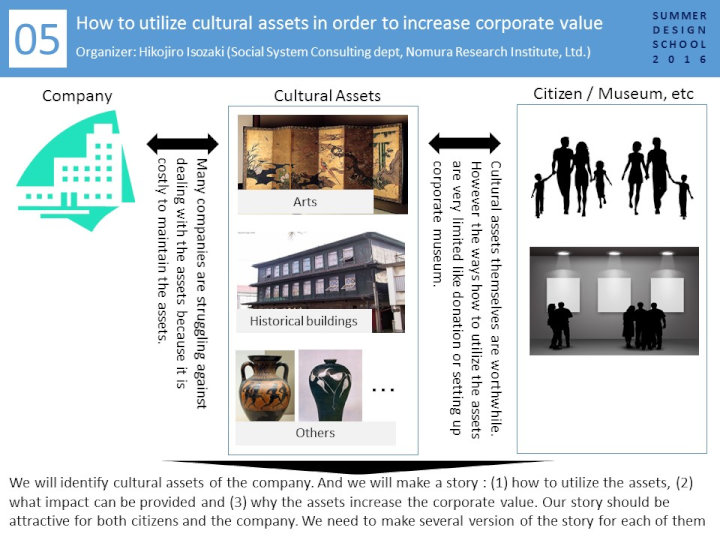Since I am working as a managing consultant, I create solutions for corporate issues. I am also studying as a fellow in the Design Innovation Consortium in Kyoto univ. Honestly speaking, this issue is my biggest concern in terms of cultural assets. I cannot say that we definitely reach the best solution for our three days. However I believe that this theme is worthwhile to consider deeply for Japan or for Kyoto.
| Name | Organization | Specialty |
|---|---|---|
| Hikojiro ISOZAKI | Nomura Research Institute, Ltd. Social System Consulting dep. | Innovation, Business creation out of Japan |
There are many cultural assets like arts, historical buildings, etc in Japan, especially in Kyoto. When companies have such cultural assets, they often donate them or set up museum to allow public to see the assets. And many companies are struggling against
dealing with the assets because it is costly to maintain the assets.
I believe that this can be a serious issue. I would like to find out some creative ways how to utilize the cultural assets in order to increase the corporate value and brand. First, we will pick up a company such as Nissin Electric, Shimadzu,
Nintendo. Then we will identify cultural assets of the company. And we will make a story : (1) how to utilize the assets, (2) what impact can be provided and (3) why the assets increase the corporate value.
Our story should be attractive for people who want to see the cultural assets. At the same time, it should be reasonable for executives of the company in order to convince them to follow the proposal. I think that we need to make several version
of the story for major stakeholders.
Under the condition of maintain the meaning and value which cultural assets have originally, we can create our insight how design thinking works in the context of corporate logic.
Also we can understand how to make and change our story based on the stakeholder. Especially, we try to use many prototyping, and find out the difference when the aim and counterparts are different.
- I will lecture the methods of design thinking, for example the way to generate ideas.
- I will prepare a document about some companies in Kyoto and their cultural assets which will be our target.
- I will prepare a document about some creative ways how to utilize companies’ cultural assets in abroad.
- I will give a guidance of some logic about how to increase corporate value.
- For brainstorming, we will use “post-it”. When we need to break through our ideas, I will use a special way to confine our scope of the ideas.
- To identify cultural assets of a company in Kyoto, it is effective to see them directly in our fieldwork.
- To think about our stakeholder like people or company, we will visit and do interviews if it is required.
- To tell our story effectively, we will try different kinds of prototypes.
- Lecture of design thinking, identifying our process
- Discuss and identifying a company in Kyoto
- Making our plan for afternoon
- Visit the company and observe its cultural assets
- Sharing each member’s observation
- Idea generation for utilization
- Discussion about our end users and stakeholders
- Making our plan for tomorrow
- Making persona of our end users
- Analyzing out end users (We can visit and do interview to our end user if it is required)
- Withdrawing insights for our end users
- Discussion about the way of cultural assets based on the insight
- Making stories for each of our end users (people, the company)
- Prepare for presentation (KRP)
- Present workshop results (KRP)
